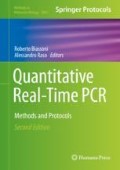Abstract
Molecular diagnosis and measurement of minimal residual disease (MRD) in patients with chronic myeloid leukemia (CML) is essential for clinical management. In the era of tyrosine kinase inhibitor therapy molecular tests including BCR-ABL1 transcript monitoring and kinase domain mutation analysis are the main tools used to inform choice of treatment, appropriate dosage and even whether therapy can be safely withdrawn. Quantitation of BCR-ABL1 oncogene transcript by real-time quantitative PCR (qPCR) is currently the gold-standard method for monitoring as it provides superior sensitivity over karyotyping and fluorescent in situ hybridization (FISH). Here we describe step-by-step methods of RNA conversion to cDNA along with the qPCR protocol which is used in one of the main reference laboratories for this test.
Access this chapter
Tax calculation will be finalised at checkout
Purchases are for personal use only
References
Nowell PC, Hungerford DA (1960) Chromosome studies on normal and leukemic human leukocytes. J Natl Cancer Inst 25:85–109
Rowley JD (1973) Chromosomal patterns in myelocytic leukemia. N Engl J Med 289:220–221. https://doi.org/10.1056/NEJM197307262890421
Khorashad JS, Deininger MW (2011) Selection of therapy: rational decisions based on molecular events. Hematol Oncol Clin North Am 25:1009–1023., vi. https://doi.org/10.1016/j.hoc.2011.09.006
Kantarjian HM, Keating MJ, Talpaz M et al (1987) Chronic myelogenous leukemia in blast crisis. Analysis of 242 patients. Am J Med 83:445–454
Huang X, Cortes J, Kantarjian H (2012) Estimations of the increasing prevalence and plateau prevalence of chronic myeloid leukemia in the era of tyrosine kinase inhibitor therapy. Cancer 118:3123–3127. https://doi.org/10.1002/cncr.26679
Druker BJ, Guilhot F, O’Brien SG et al (2006) Five-year follow-up of patients receiving imatinib for chronic myeloid leukemia. N Engl J Med 355:2408–2417. https://doi.org/10.1056/NEJMoa062867
Eissa H, Gooley TA, Sorror ML et al (2011) Allogeneic hematopoietic cell transplantation for chronic myelomonocytic leukemia: relapse-free survival is determined by karyotype and comorbidities. Biol Blood Marrow Transplant 17:908–915. https://doi.org/10.1016/j.bbmt.2010.09.018
Melo JV, Gordon DE, Cross NC et al (1993) The ABL-BCR fusion gene is expressed in chronic myeloid leukemia. Blood 81:158–165
Cross NC, Melo JV, Feng L et al (1994) An optimized multiplex polymerase chain reaction (PCR) for detection of BCR-ABL fusion mRNAs in haematological disorders. Leukemia 8:186–189
Baccarani M, Deininger MW, Rosti G et al (2013) European LeukemiaNet recommendations for the management of chronic myeloid leukemia: 2013. Blood 122:872–884. https://doi.org/10.1182/blood-2013-05-501569
Cross NC, White HE, Colomer D et al (2015) Laboratory recommendations for scoring deep molecular responses following treatment for chronic myeloid leukemia. Leukemia 29:999–1003. https://doi.org/10.1038/leu.2015.29
Cross NC, Hochhaus A, Muller MC (2015) Molecular monitoring of chronic myeloid leukemia: principles and interlaboratory standardization. Ann Hematol 94(Suppl 2):S219–S225. https://doi.org/10.1007/s00277-015-2315-1
Deininger MW, Goldman JM, Melo JV (2000) The molecular biology of chronic myeloid leukemia. Blood 96:3343–3356
Roman J, Jimenez A, Barrios M et al (2001) E1A3 as a unique, naturally occurring BCR-ABL transcript in an indolent case of chronic myeloid leukaemia. Br J Haematol 114:635–637
Jinawath N, Norris-Kirby A, Smith BD et al (2009) A rare e14a3 (b3a3) BCR-ABL fusion transcript in chronic myeloid leukemia: diagnostic challenges in clinical laboratory practice. J Mol Diagn 11:359–363. https://doi.org/10.2353/jmoldx.2009.090008
Laurent E, Talpaz M, Kantarjian H et al (2001) The BCR gene and Philadelphia chromosome-positive leukemogenesis. Cancer Res 61:2343–2355
Claudiani S, Apperley JF, Gale RP et al (2017) E14a2 BCR-ABL1 transcript is associated with a higher rate of treatment-free remission in individuals with chronic myeloid leukemia after stopping tyrosine kinase inhibitor therapy. Haematologica 102:e297–e299. https://doi.org/10.3324/haematol.2017.168740
Hanfstein B, Lauseker M, Hehlmann R et al (2014) Distinct characteristics of e13a2 versus e14a2 BCR-ABL1 driven chronic myeloid leukemia under first-line therapy with imatinib. Haematologica 99:1441–1447. https://doi.org/10.3324/haematol.2013.096537
Melo JV (1996) The diversity of BCR-ABL fusion proteins and their relationship to leukemia phenotype. Blood 88:2375–2384
Li S, Ilaria RL Jr, Million RP et al (1999) The P190, P210, and P230 forms of the BCR/ABL oncogene induce a similar chronic myeloid leukemia-like syndrome in mice but have different lymphoid leukemogenic activity. J Exp Med 189:1399–1412
Wittwer CT, Herrmann MG, Moss AA et al (1997) Continuous fluorescence monitoring of rapid cycle DNA amplification. BioTechniques 22:130–131. 134–138
Holland PM, Abramson RD, Watson R et al (1991) Detection of specific polymerase chain reaction product by utilizing the 5′-3′ exonuclease activity of Thermus aquaticus DNA polymerase. Proc Natl Acad Sci U S A 88:7276–7280
Livak KJ, Flood SJ, Marmaro J et al (1995) Oligonucleotides with fluorescent dyes at opposite ends provide a quenched probe system useful for detecting PCR product and nucleic acid hybridization. PCR Methods Appl 4:357–362
White H, Deprez L, Corbisier P et al (2015) A certified plasmid reference material for the standardisation of BCR-ABL1 mRNA quantification by real-time quantitative PCR. Leukemia 29:369–376. https://doi.org/10.1038/leu.2014.217
Wang YL, Lee JW, Cesarman E et al (2006) Molecular monitoring of chronic myelogenous leukemia: identification of the most suitable internal control gene for real-time quantification of BCR-ABL transcripts. J Mol Diagn 8:231–239. https://doi.org/10.2353/jmoldx.2006.040404
Gerrard G, Mudge K, Foskett P et al (2012) Fast-mode duplex qPCR for BCR-ABL1 molecular monitoring: innovation, automation, and harmonization. Am J Hematol 87:717–720. https://doi.org/10.1002/ajh.23212
Collins SJ (1987) The HL-60 promyelocytic leukemia cell line: proliferation, differentiation, and cellular oncogene expression. Blood 70:1233–1244
Bustin SA, Benes V, Garson JA et al (2009) The MIQE guidelines: minimum information for publication of quantitative real-time PCR experiments. Clin Chem 55:611–622. https://doi.org/10.1373/clinchem.2008.112797
Kutyavin IV, Afonina IA, Mills A et al (2000) 3′-minor groove binder-DNA probes increase sequence specificity at PCR extension temperatures. Nucleic Acids Res 28:655–661
Westgard JO, Barry PL, Hunt MR et al (1981) A multi-rule Shewhart chart for quality control in clinical chemistry. Clin Chem 27:493–501
Author information
Authors and Affiliations
Corresponding author
Editor information
Editors and Affiliations
Rights and permissions
Copyright information
© 2020 Springer Science+Business Media, LLC, part of Springer Nature
About this protocol
Cite this protocol
Dominy, K., Mokretar, K., Reid, A.G., Khorashad, J.S. (2020). Molecular Monitoring of Chronic Myeloid Leukemia. In: Biassoni, R., Raso, A. (eds) Quantitative Real-Time PCR. Methods in Molecular Biology, vol 2065. Humana, New York, NY. https://doi.org/10.1007/978-1-4939-9833-3_12
Download citation
DOI: https://doi.org/10.1007/978-1-4939-9833-3_12
Published:
Publisher Name: Humana, New York, NY
Print ISBN: 978-1-4939-9832-6
Online ISBN: 978-1-4939-9833-3
eBook Packages: Springer Protocols

